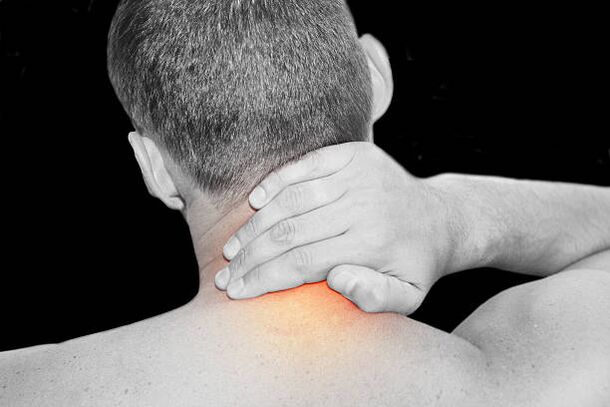Osteochondrosis of the cervical spine is a degenerative-dystrophic pathology that affects the vertebrae, cartilaginous discs and ligaments.If we take the term literally, osteo means “bone”, chondrosis means “cartilage”.Those.cervical osteochondrosis is associated with changes in the tissue structures of the spine, in which the intervertebral discs lose their functionality and at the same time the nutrition of the vertebral bodies themselves is disrupted.
Cervical osteochondrosis, the symptoms and treatment of which we will consider today, is a fairly common disease.According to statistics, after 35 years, osteochondrosis is found in 40-85% of the population, regardless of the standard of living and country of residence.The share of pathologies of the cervical spine represents up to 30% of all identified cases.
Most often the disease develops in the C 5 – C 7 region, since they are the most mobile and important vessels that supply the brain and can be involved in the pathological process.

Symptoms of cervical osteochondrosis
The symptoms of cervical osteochondrosis are varied and the clinical manifestations depend on which vertebra is affected by the disease.Osteochondrosis of the neck is characterized by sudden "throws", in which the patient feels sharp pain that limits movement and a crunching sound when turning the head.Let's consider the painful symptoms of osteochondrosis of the cervical spine depending on the location of the vertebral lesions:
- 1st vertebra: pain and numbness in the back of the head;
- 2nd vertebra: pain in the back of the head, discomfort in the crown area;
- 3 vertebrae - pain in the neck, possible disturbance of speech, sensitivity and innervation of the tongue;
- 4 vertebrae - decreased muscle tone of the neck, headache, discomfort when breathing, pain in the shoulders, shoulder blades, in the heart area, right hypochondrium;
- 5-6 vertebrae: pain in the shoulders, forearms, scapula, thumb;
- 7th vertebra: pain in the shoulder blade, hand, 2-4 fingers, possible loss of sensation in these areas.
With extensive osteochondrosis affecting several vertebrae, symptoms may overlap, making an accurate diagnosis difficult.
Dizziness with cervical osteochondrosis deserves special attention, because it is the main symptom of the disease.It occurs suddenly and can be quite strong.
Headache with cervical osteochondrosis may be accompanied by dizziness and cannot be relieved with analgesics, since it is a consequence of compression of the vertebral arteries.Muscle pain with cervical osteochondrosis is not always present, but headaches can be a constant symptom.
Vertebral artery syndrome with cervical osteochondrosis
Vertebral artery syndrome with cervical osteochondrosis occurs against the background of compression of the vertebral arteries and includes many manifestations:
- debilitating headache that worsens when you turn or tilt your head;
- deterioration of vision: double vision, decreased sharpness, feeling of pain and dryness of the eyes, flickering of spots;
- disorders such as angina pectoris, complain of chest pain, shortness of breath, changes in blood pressure.It is very important to differentiate the diagnosis correctly and timely, since angina pectoris and syndromes associated with cervical osteochondrosis are treated not only with different drugs, but also with different specialists;
- short-term hearing impairment - sudden appearance of noise or ringing in the ears, associated with short-term dizziness and darkening of the eyes;
- Vomiting and concomitant disturbances of consciousness are possible.Most often, such signs are provoked by a sudden bending or rotation of the head;
- brain disorders similar to ischemic stroke.Also in this case, differentiated and timely diagnosis is very important.
Treatment of cervical osteochondrosis
Treatment of cervical osteochondrosis of the spine begins only after a detailed medical examination.The diagnosis is made using X-rays of the neck and modern methods: CT or MRI of the spine.If the diagnosis of cervical osteochondrosis is confirmed, treatment will be carried out by a neurologist.In case of initial manifestations of the disease, drugs can be prescribed only during the period of exacerbation, and the basis of therapy during the period of remission are physiotherapy, massage and correction of the patient's regimen.
Treatment of osteochondrosis of the cervical spine includes several mandatory aspects:
- mode correction.You need to properly organize your night's rest;the use of orthopedic pillows is recommended.
- exclusion of loads.If you spend your entire working day at your office desk, spend a few minutes every 2 hours stretching your neck and also do eye exercises.
- drug therapy, taking drugs prescribed by the doctor.Once again, we strongly recommend that you do not rely on the advice of local doctors.
- physiotherapeutic procedures.You will receive a referral for them to a neurologist, and a doctor-physiotherapist will prescribe detailed therapy.Don't be tempted by the promises of non-professional masseurs.Remember that the neck is a very responsible department.If massage or manual procedures are performed by a non-professional, the matter may end in complications.
A lot of literature has been written about how to treat osteochondrosis in the cervical spine using traditional methods.Be careful, other popular recipes do not stand up to criticism.Discuss any traditional therapy method with your doctor before using it.


























